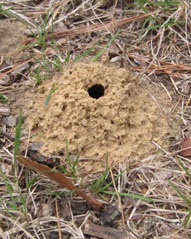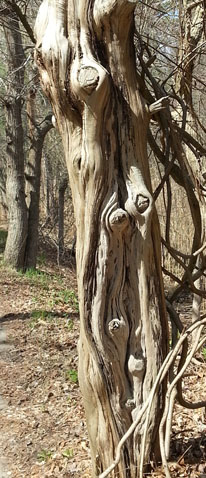
Looking more closely, I saw a number of holes in the ground, like the one shown to the left, with flying insects going in and out. These were much larger than the holes in an anthill. To give you an idea of scale, the holes were about 7 mm in diameter (about a quarter inch). Looking to see if there were any more, I was startled to find that there were hundreds of these holes, covering the majority of the triangle which remains from the old training field. The picture below gives you an idea of the large area covered, and it only shows a small portion of it. 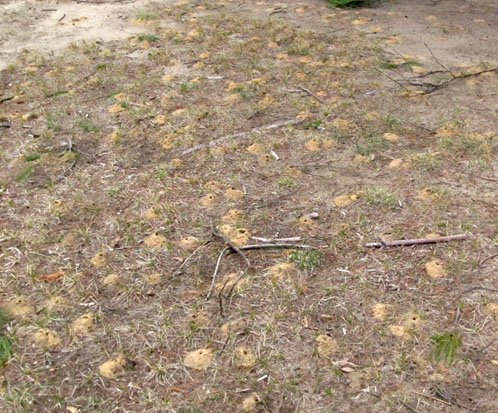 A Google search reveals that there are many different species of bees and wasps that live in the ground like this. I confess I didn't take a really close look at the insects flying in and out of the holes, so I don't feel I can identify them. The next link will take you to a webpage called Bees in Turf which identifies some of the possibilities. What I saw looked very much like the image shown on that page depicting the holes of "ground-nesting bees". In a couple of previous blog entries, I discussed some of the things in nature going on around us that we often don't see, but which are revealed indirectly by the tracks that they leave. For example, take a look at the entries Tracks and Life in the 'burbs. I was curious as to the area of the lawn that was mostly covered with these holes (perhaps 70 to 80 percent of it). With a bit of searching, I found a web site by Google Map Developers containing an area calculator. I outlined the area in question, and you can see the result of the calculation below: 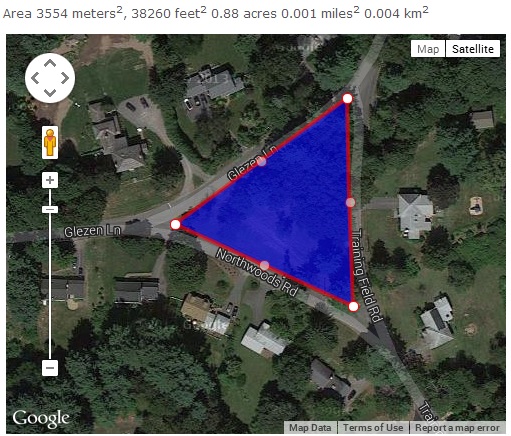 You can see the area calculated above the image - it's: So that's well over half an acre of bee holes (an acre is 0.4 hectares, 4,047 square meters). But that picture was taken over six weeks ago, on April 14, 2014. I walked around the triangle earlier today, May 29, 2014, and all the bee holes are gone. I walked to the triangle to see if there's any indication that the southern part of the triangle is actually named "Northwoods Road", as shown on the map. There isn't. In fact, both roads have signs where they intersect Training Field Road which proclaim them to be "Glezen Lane", and the addresses of the three houses that might be considered to be on "Northwoods Road" are in fact Glezen Lane addresses. But there's at least one address on Northwoods Road in a printed Wayland phone book, and obviously Google Maps (and MapQuest, for that matter) are using some database in which this segment is named "Northwoods Road".
I find this rather attractive, but only because I can view it as something abstract. If you think about it, it's the remains of a tree that has died. It's sort of a corpse, so in that sense perhaps I ought to find it ugly, or even creepy. I wouldn't find the rotting remains of an animal to be beautiful. But somehow, a tree is far enough removed from us that I can look upon its remains as sort of an abstract sculpture. I once heard a case of this sort of association with an image that hit closer to home, as it was an image of a baby. The baby had a strange overall coloration, and coming across the image in a book, someone found the picture to be rather beautiful. However, a doctor who was also viewing the image was repulsed by it. He explained that the coloration indicated the baby was suffering from some particular medical condition for which there was no treatment, so that the baby was going to die. His knowledge of what the image actually depicted made it impossible for him to see it as something that might be beautiful in an abstract sense. There's a rather remarkable tree that has stood in front of the Town of Lincoln public library for many years. Its trunk looks as if someone grabbed the top of the tree and twisted it. When we first came to this area, over 40 years ago, the tree was still alive, but it seems to have since died. After I snapped a cell-phone picture of the dead tree trunk shown above, it occurred to me that I ought to preserve a photo of the Lincoln tree, before it gets taken down (falling branches will eventually become a hazard). So here it is: 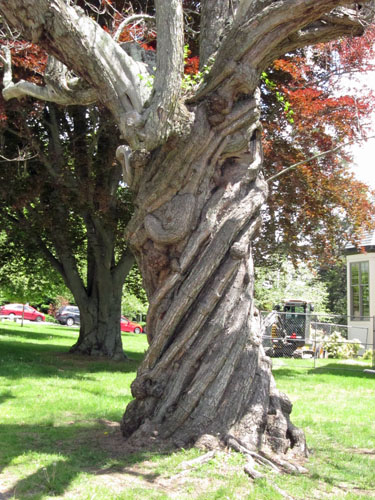 Click the next link if you're curious enough to want to also see it from the other side. When you walk around, it's fun to keep your eyes open.   |
